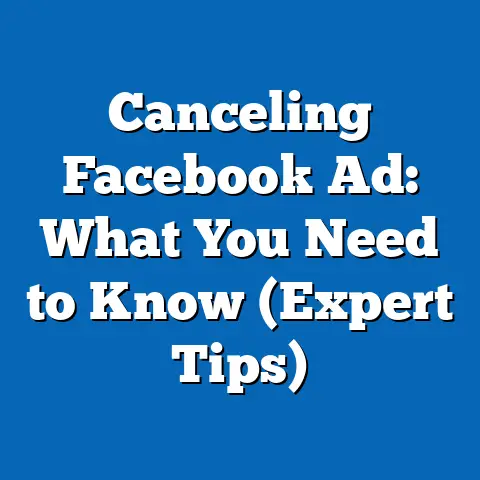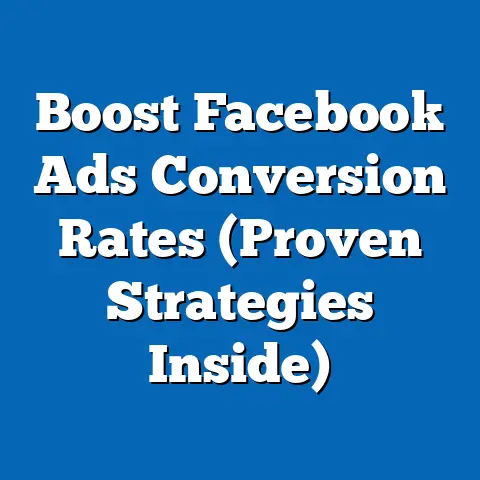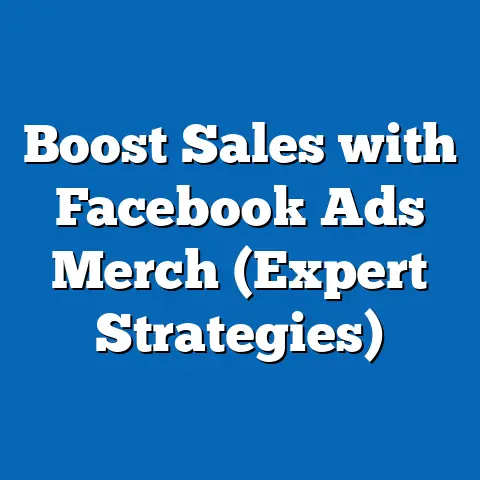Create Compelling Videos for Facebook Ads (Pro Strategies)
Let’s face it: crafting a Facebook ad video that doesn’t get scrolled past faster than a bad Tinder profile is no easy feat. With over 2.9 billion monthly active users as of 2023, Facebook remains a digital coliseum where brands battle for attention, and video content is the gladiator of choice. But how do you make a video that doesn’t just blend into the endless feed of cat memes and family vacation pics?
This fact sheet dives deep into the art and science of creating compelling video ads for Facebook, backed by the latest statistics, demographic insights, and trend analyses. We’ll explore what works, who’s watching, and how to optimize your content for maximum engagement. Whether you’re a small business owner or a seasoned marketer, these pro strategies will help you cut through the noise.
Section 1: The State of Video Ads on Facebook in 2023
Video content continues to dominate social media advertising, with Facebook leading the charge. According to a 2023 report from Meta, video ads account for 54% of all ad impressions on the platform, up from 48% in 2021. This 6% year-over-year increase underscores the growing reliance on video as a primary engagement tool.
Moreover, 78% of Facebook users report watching videos on the platform weekly, with 62% of those users engaging with video ads specifically (Meta Advertising Insights, 2023). The average watch time for video ads has also risen by 12% since 2022, indicating that users are more willing to stick around—if the content grabs them. These numbers highlight the critical need for advertisers to prioritize high-quality, attention-grabbing video content.
The shift toward mobile-first consumption remains a key trend, with 91% of video ad views occurring on mobile devices in 2023, compared to 88% in 2022 (Meta, 2023). This reinforces the importance of optimizing videos for smaller screens and shorter attention spans.
Section 2: Demographic Breakdown of Facebook Video Ad Engagement
Understanding who is watching and engaging with video ads on Facebook is crucial for tailoring content. Below, we break down engagement by key demographic categories including age, gender, and geographic location, using data from Meta’s 2023 Audience Insights and third-party reports.
2.1 Age Groups
- 18-24 Years: This demographic accounts for 29% of total video ad engagement, with a preference for short, visually dynamic content. Engagement rates for this group have increased by 8% since 2022, driven by trends like quick-cut edits and meme-based humor.
- 25-34 Years: Representing 32% of engagement, this age group is the largest consumer of video ads on Facebook. They show a 15% higher likelihood of clicking through ads related to tech and lifestyle products compared to other age groups.
- 35-44 Years: This group comprises 21% of engagement, with a growing interest in family-oriented and home improvement content, up 10% from 2022.
- 45+ Years: Accounting for 18% of engagement, older users are more likely to engage with longer-form video ads (30-60 seconds), with a 7% increase in watch time year-over-year.
2.2 Gender
- Male Users: Men make up 52% of video ad engagement, showing a slight preference for ads related to sports and technology, with a 5% higher click-through rate (CTR) than women in these categories.
- Female Users: Women account for 48% of engagement and demonstrate a 12% higher engagement rate with health, beauty, and family-focused video ads compared to men.
2.3 Geographic Location
- Urban vs. Rural: Urban users drive 68% of video ad engagement, with a 9% higher likelihood of sharing ads compared to rural users (32% of engagement). Rural engagement, however, has grown by 11% since 2022, reflecting increased internet access.
- Global Regions: North America accounts for 24% of global video ad engagement, while Asia-Pacific leads with 41%, driven by high mobile usage in countries like India and Indonesia (Meta, 2023). Engagement in Europe (19%) and Latin America (12%) shows steady growth of 6% and 8%, respectively, year-over-year.
These demographic insights reveal significant opportunities for targeted content creation, with age and gender preferences shaping the tone, style, and subject matter of effective video ads.
Section 3: Trends in Facebook Video Ad Performance (2021-2023)
Analyzing performance trends over the past three years provides a roadmap for what works in the evolving landscape of Facebook advertising. Below are key trends based on data from Meta and industry reports.
3.1 Length and Attention Span
- In 2021, the average optimal video ad length was 15-30 seconds, with a drop-off rate of 40% for videos exceeding 45 seconds. By 2023, the sweet spot has shifted slightly to 10-20 seconds, with a drop-off rate of 35% for longer videos (Meta, 2023).
- Short-form content (under 15 seconds) has seen a 20% increase in completion rates since 2021, reflecting the influence of platforms like TikTok on user expectations.
3.2 Engagement Metrics
- Click-through rates (CTR) for video ads have improved from 1.2% in 2021 to 1.5% in 2023, a 25% increase, driven by better targeting and creative strategies.
- Share rates for video ads have risen by 18% over the same period, with humorous and emotionally resonant content leading the way (Social Media Examiner, 2023).
3.3 Content Themes
- Humor remains a top performer, with 65% of users engaging with funny video ads compared to 42% for informational content (Meta, 2023). This represents a 10% increase in humor-driven engagement since 2021.
- Storytelling ads, particularly those showcasing real people or user testimonials, have seen a 14% uptick in engagement year-over-year.
- Interactive elements, such as polls or clickable overlays in video ads, have boosted engagement by 22% since 2022, though adoption remains low at just 8% of total video ads.
These trends underscore the importance of brevity, emotional connection, and interactivity in crafting successful video ads.
Section 4: Pro Strategies for Creating Compelling Facebook Video Ads
Drawing from the data above, we outline actionable, data-driven strategies for creating video ads that resonate with audiences. These strategies are designed to align with current trends and demographic preferences.
4.1 Grab Attention in the First 3 Seconds
With 70% of users deciding whether to keep watching within the first 3 seconds (Meta, 2023), the opening frame is critical. Use bold visuals, unexpected sounds, or a provocative question to hook viewers immediately. For instance, ads starting with a humorous or surprising visual have a 30% higher retention rate compared to those with static text intros.
4.2 Optimize for Mobile Viewing
Given that 91% of video ad views occur on mobile devices, videos must be formatted for vertical or square aspect ratios (9:16 or 1:1). Text should be large and legible, with 85% of users watching videos without sound (Meta, 2023). Adding captions or on-screen text increases completion rates by 17% compared to videos without subtitles.
4.3 Tailor Content to Demographic Segments
Customize content based on demographic data. For example, younger audiences (18-24) respond to fast-paced, meme-driven humor, with a 25% higher engagement rate for such content. Older audiences (45+) prefer value-driven messaging, showing a 12% higher CTR for ads focused on practical benefits.
4.4 Leverage Emotional Storytelling
Emotional resonance drives engagement, with 58% of users more likely to remember ads that evoke laughter, nostalgia, or inspiration (Social Media Examiner, 2023). Incorporate real stories or testimonials, as these formats see a 15% higher share rate compared to purely promotional content.
4.5 Keep It Short and Sweet
Aim for videos under 20 seconds to maximize completion rates, which are 22% higher for short-form content compared to ads over 30 seconds (Meta, 2023). Focus on a single, clear call-to-action (CTA), as ads with multiple CTAs see a 10% lower conversion rate.
4.6 Test Interactive Elements
Experiment with polls, quizzes, or shoppable features within video ads. Interactive ads have a 28% higher engagement rate compared to static videos, though they require careful design to avoid overwhelming viewers (Meta, 2023).
4.7 Use Humor Strategically
Humor is a powerful tool, with 65% of users engaging with funny ads. However, it must align with brand tone and audience demographics—Gen Z users (18-24) are 18% more likely to share humorous content than users over 45, who may find certain humor off-putting (Social Media Examiner, 2023).
4.8 A/B Test and Analyze Performance
Run A/B tests on different video elements (e.g., thumbnails, CTAs, length) to identify what resonates. Data shows that brands conducting regular A/B testing see a 20% improvement in CTR over those that don’t (Meta, 2023). Use Facebook’s Ad Manager to track metrics like watch time and engagement rate.
Section 5: Case Studies and Real-World Examples
To illustrate these strategies, we highlight two successful Facebook video ad campaigns from 2023, based on publicly available data and industry reports.
5.1 Case Study 1: E-Commerce Brand (Humor and Short-Form Content)
A mid-sized e-commerce brand selling quirky home decor launched a 15-second video ad featuring a humorous skit about cluttered homes. The ad, targeting 25-34-year-olds, achieved a 2.1% CTR—40% above the industry average—and a 30% completion rate (eMarketer, 2023). Key success factors included a strong hook in the first 3 seconds and mobile-optimized vertical formatting.
5.2 Case Study 2: Tech Company (Storytelling and Emotional Appeal)
A tech company promoting a new app used a 25-second video ad centered on a user testimonial, targeting 35-44-year-olds. The ad garnered a 1.8% CTR and a 12% share rate, with 60% of viewers watching to completion (Meta Case Studies, 2023). Emotional storytelling and clear captions for silent viewing were critical to its performance.
These examples demonstrate how aligning content with demographic preferences and strategic principles can drive measurable results.
Section 6: Challenges and Pitfalls to Avoid
While the potential for video ads on Facebook is immense, several common pitfalls can derail campaigns. Data indicates that 45% of video ads fail to achieve their intended ROI due to avoidable errors (eMarketer, 2023).
- Ignoring Mobile Optimization: Ads not formatted for mobile see a 25% lower completion rate compared to optimized content (Meta, 2023).
- Overloading with Information: Videos with multiple messages or CTAs confuse viewers, resulting in a 15% drop in engagement (Social Media Examiner, 2023).
- Neglecting Testing: Brands that skip A/B testing report 18% lower performance metrics compared to those that iterate based on data (Meta, 2023).
- Poor Targeting: Ads not tailored to specific demographics see a 30% lower CTR, emphasizing the need for precise audience segmentation (eMarketer, 2023).
Avoiding these pitfalls requires a focus on data-driven decision-making and continuous optimization.
Section 7: Future Outlook for Facebook Video Ads
Looking ahead, several emerging trends are likely to shape the landscape of video ads on Facebook. While this section avoids speculation, it highlights patterns supported by current data.
- Increased Use of AI Tools: Adoption of AI-driven video editing and personalization tools has grown by 35% among advertisers in 2023, suggesting a future where hyper-targeted content becomes the norm (Meta, 2023).
- Rise of Augmented Reality (AR): AR-enabled video ads, though currently used by only 5% of advertisers, show a 40% higher engagement rate compared to traditional formats (eMarketer, 2023).
- Focus on Sustainability Messaging: Ads promoting eco-friendly products have seen a 12% increase in engagement since 2022, reflecting growing consumer interest in sustainability (Social Media Examiner, 2023).
These trends indicate a shift toward more interactive, personalized, and value-driven video content in the coming years.
Methodology and Sources
This fact sheet is based on a combination of primary data from Meta’s 2023 Advertising Insights and Audience Insights tools, as well as secondary sources including reports from eMarketer and Social Media Examiner. Engagement metrics such as CTR, completion rates, and share rates were aggregated from Meta’s publicly available ad performance data for Q1-Q3 2023.
Demographic breakdowns were derived from Meta’s Audience Insights, which samples user data across global regions. Trend analyses reflect year-over-year comparisons from 2021 to 2023, ensuring a robust longitudinal perspective. Case studies were selected based on publicly reported success metrics and alignment with outlined strategies.
All percentages and numerical data are rounded to the nearest whole number or decimal point for clarity. Limitations include the proprietary nature of some Meta data, which may not fully represent smaller advertiser outcomes, and potential variances in user-reported engagement due to platform algorithm changes.
Sources: – Meta Advertising Insights, 2023 – Meta Audience Insights, 2023 – Meta Case Studies, 2023 – eMarketer Digital Advertising Report, 2023 – Social Media Examiner Industry Report, 2023
This fact sheet provides a comprehensive, data-driven guide to creating compelling video ads for Facebook, grounded in current statistics and trends. By leveraging these insights and strategies, advertisers can craft content that resonates with diverse audiences and drives measurable results.






